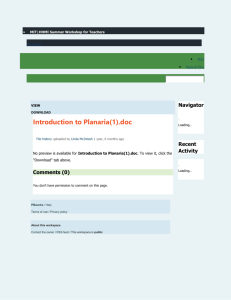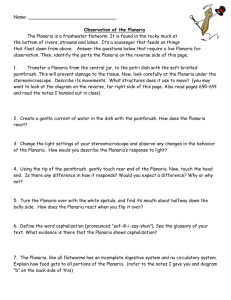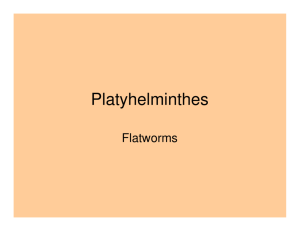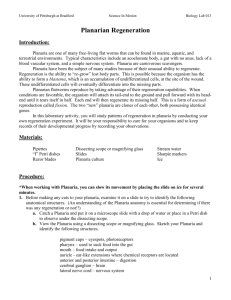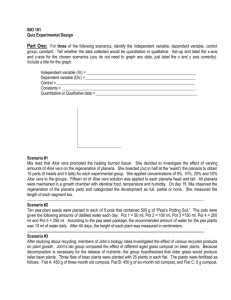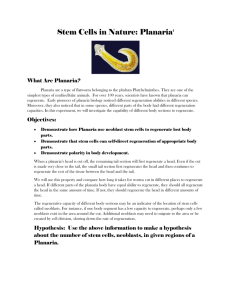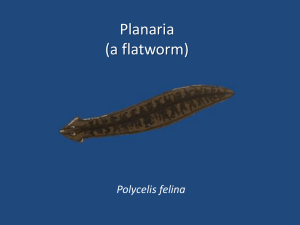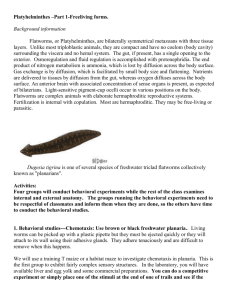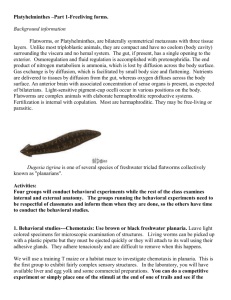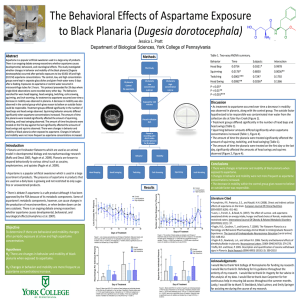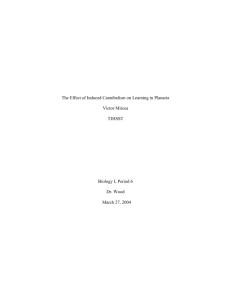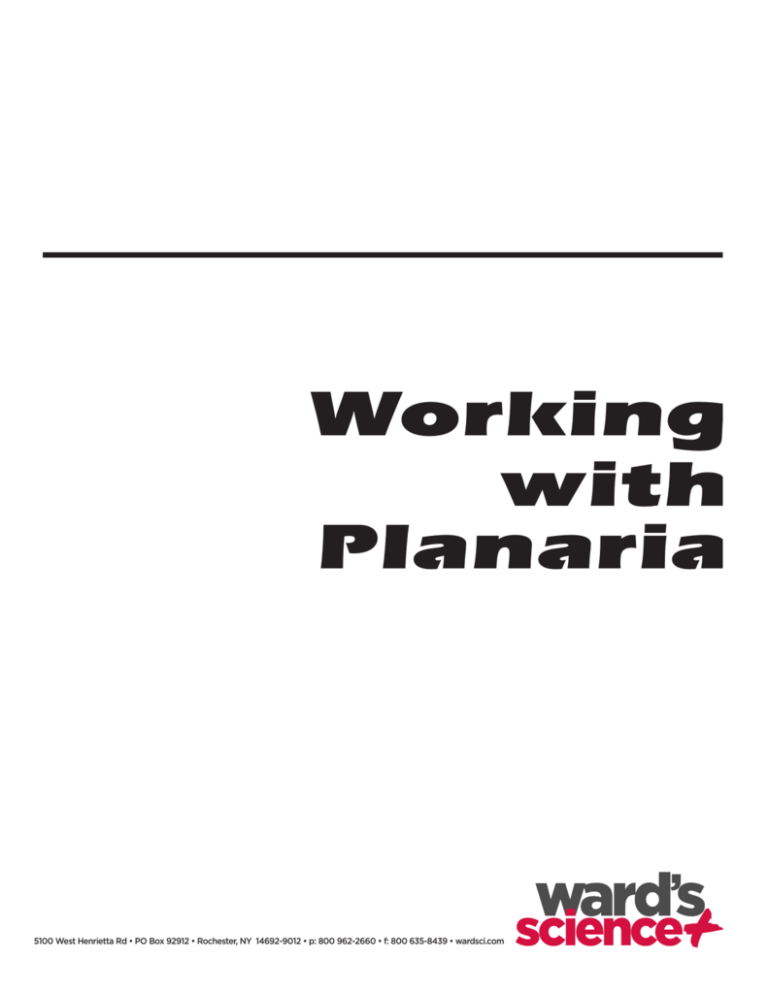
Working
with
Planaria
8FTU )FOSJFUUB 3E t 10 #PY t 3PDIFTUFS /: t Q t G t XBSETDJDPN
Working with Planaria
Introduction
Planaria are free-living aquatic flatworms known as Turbellarians, of the phylum Platyhelminthes (Greek for “flatworm”).
Turbellarians are also known as “triclads”, which refers to their triple gut with a single anterior and two posterior branches.
Other characteristics of planaria include pigmentation which can be gray-brown, brown, white, or black; simple nervous system; and head with “eyes”. The eyes have no lenses and so cannot form an image, but they are sensitive to light. (To get a
sense of how Planaria “see”, close your eyes and face a bright light.) Note, however, that planaria are negatively phototaxic —
they avoid light; they hide under rocks, leaves, and other debris in aquatic habitats.
Planaria are carnivorous, eating living or dead animal matter. When they eat, they use their long, muscular pharynx, which
they evert to almost one-half their body length.
Reproduction
Planaria reproduce both sexually and asexually. There are two methods of asexual reproduction: fragmentation and spontaneous “dropping tails”. Fragmentation usually begins with a transverse constriction just behind the pharynx, which increases
until the two parts separate and move away from each other. The head grows a new tail, and the tail grows a new head. In
spontaneous “dropping tails”, planaria in very stagnant water will frequently “drop” their tails, and the tails regenerate to form
complete animals. This condition usually results in stunted animals, or dwarfs, which remain in this state until water conditions improve.
Because planaria are hermaphroditic — each animal possesses complete male and female systems — they reproduce sexually
by producing “summer” eggs and “winter” eggs. Summer eggs are thin-shelled and transparent; winter eggs are usually black
and on stalks. While summer eggs hatch quickly, winter eggs take longer to hatch; they may even remain dormant throughout the winter, and they are capable of withstanding unfavorable environmental conditions.
Collection
Planaria can be found on the underside of rocks, leaves, and other objects in the shallow water of streams, ponds, and rivers,
as well as in aquatic vegetation such as Elodea and filamentous algae. The most common species found in running water are
Dugesia dorotocephala, Cura foremani, and Phagocata velata; in standing water Dugesia tigrina and Phagocata vernalis are common. Procotyla fluviatilis can be found in running water, standing water, and even brackish water.
To collect planaria, wash off the underside of objects from a stream or pond bottom into a container of water. Planaria can
also be collected by using “bait” — a cube of raw beef liver tied with a string and left to drift near submerged rocks for 15 or
20 minutes; shake off any planaria that adhere to the liver into a container of water. You may also remove a large amount of
aquatic vegetation and place it in covered containers of water. As the oxygen content decreases, the planaria will rise to the
surface where they can be easily removed.
Care and Feeding
Keep planaria in a covered shallow enamel pan; covered dishes may also be used. (Most species will also thrive in an aquarium.)
Use pond or spring water; salts in tap water make it toxic to planaria. If tap water is used, remove salts with a water conditioner.
Change the water every day or at least every other day. While planaria can survive in standing water, the water should be aerated. Keep water at approximately 21°C or lower. If necessary, store the container with planaria on the bottom shelf of a refrigerator. To help the planaria avoid light, add cover such as slate or broken pieces of flower pots to the container. Clean the container once a week.
Feed the planaria beef liver approximately three times a week; the liver can be stored frozen. They will also eat earthworm fragments and chopped mealworms. Procotyla fluviatilis is an exception; this species requires small living crustaceans. Remove any
food that has not been eaten two or three hours after feeding, then change the water.
Note: An interesting result of heavy feeding is the spontaneous “tail dropping” described above. If no food is available, a
healthy planaria can survive for up to three months without harmful effects.
2
8FTU )FOSJFUUB 3E t 10 #PY t 3PDIFTUFS /: t Q t G t XBSETDJDPN
1
2
11
Figure A
Dugesia tigrina
Diagrammatic
representation
1 Ocellus
2 Auricle
3 Anterior branch
of intestine
4 Gut diverticula
5 Areas of dispersed and
concentrated pigment
6 Mouth
7 Everted pharynx
(proboscis)
8 Posterior branch
(2) of intestine
3
10
9
8
4
7
5
6
Figure B
Planarian
Section through pharynx
Area of Figure C
7 Ciliated ventral
epidermis
8 Diverticula of
intestine
9 Parenchyma
10 Longitudinal
muscle fibers
11 Circular muscle layer
1 Dorsal epidermis with
many rhadbites
2 Pharynx (proboscus)
3 Pharyngeal pouch
4 Posterior branch
of intestine
5 Mouth, obliquely cut
6 Nerve Cord
7
1
2
8
3
4
5
9
6
4
Figure C
Planarian
Cross-section greatly magnified diagrammatic
1 Lumen of pharynx
2 Cilia of epithelial cells
lining lumen
3 Longitudinal muscle
fibers (longitudinal
section)
4 Longitudinal muscle
fibers (cross section)
5 Glandular cells
6 Circular muscle fibers
213-0006 © 2005 Ward’ s Science. All rights reserved. Rev.. 3/13
8FTU )FOSJFUUB 3E t 10 #PY t 3PDIFTUFS /: t Q t G t XBSETDJDPN
4
6
10
11
7 Pharyngeal pouch
8 Mouth, cut obliquely
9 Parenchyma
(mesenchyme cells)
10 Rhabdite (rod-shaped
structure present
in epidermis of
flatworms)
11 Ciliated ventral
epidermis

